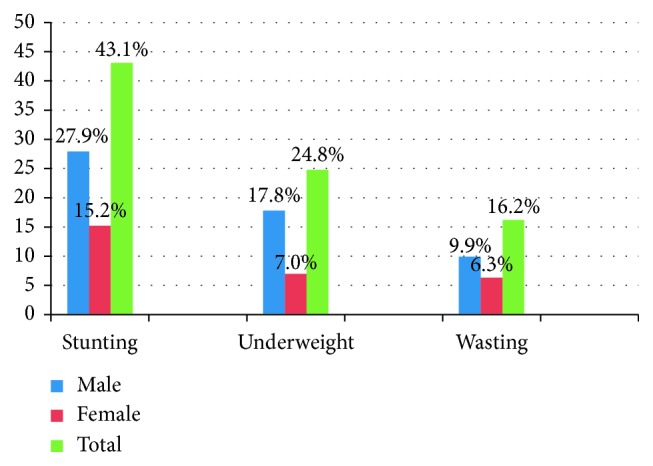Malnutrition among kids stays one of crucial causes of morbidity and mortality in the world. In Ethiopia, malnutrition is one of essentially the most critical public well being downside and the most important in the world.
This research aimed to evaluate the prevalence of malnutrition and related elements among under-five kids in pastoral communities of Afar Regional state, Northeast Ethiopia.MethodsA community-based cross-sectional research was performed on 840 kids aged 6-59 months from March 01-25, 2017. A multistage cluster sampling methodology was used to pick out the research contributors.
A structured questionnaire was used and anthropometric measurements had been taken to gather information. EPI Data 3.1 and SPSS model 20.Zero had been used for information entry and evaluation, respectively.
Bivariate and multivariable logistic regression evaluation was used to determine the elements related to malnutrition. The statistical significance was declared at p worth < 0.05 with 95% confidence intervals in the ultimate mannequin.
The research discovered the prevalence of losing, stunting, and underweight was 16.2% (95% CI: 13.8-18.8%), 43.1% (95% CI: 39.8-46.5%), and 24.8% (95% CI: 21.9-27.8%), respectively. Family measurement (AOR = 2.72, 95% CI: 1.62-4.55), prelacteal feeding (AOR = 3.81, 95% CI: 1.79-5.42), and diarrhoea in the previous two weeks (AOR = 4.57, 95% CI: 2.56-8.16) had been related to losing. And intercourse of youngster (AOR = 1.98, 95% CI: 1.46-2.72), age of youngster ((12-23 months: AOR = 3.44, 95% CI: 2.24-5.29); (24-35 months: AOR = 3.58, 95% CI: 2.25-5.69); and (36-59 months: AOR = 4.42, 95% CI: 2.79-6.94)), and immunization standing of youngster (AOR = 3.34, 95% CI: 1.31-4.81) had been predictors for stunting. Moreover, mom’s schooling (AOR = 4.06, 95% CI: 2.01-8.19), intercourse of youngster (AOR = 1.83, 95% CI: 1.29-2.94), prelacteal feeding (AOR = 2.81, 95% CI: 1.64-3.72), and immunization standing of youngster (AOR = 3.17, 95% CI: 2.14-4.99) had been considerably related to underweight.
This research indicated that youngster malnutrition was excessive among under-five kids. Family measurement of 5 and above, receiving prelacteal feeding, and diarrhoea in the previous two weeks had been positively related to losing.
Male youngster, growing age of youngster, and not absolutely immunized youngster had been optimistic predictors for growing stunting. Maternal illiteracy, male youngster, prelacteal feeding, and not absolutely immunized youngster had been elements affecting underweight. Promoting use of household planning, stopping diarrhoeal ailments, and vaccinating kids built-in with the entry of vitamin education schemes are very important interventions to enhance dietary standing of the youngsters.

Causes of Treatment Abandonment of Pediatric CancerSufferers – Experience in a Regional Cancer Centre in NorthEast India
Introduction: Refusal and abandonment of therapy is usually thought of as an essential cause for poor survival ofpediatric most cancers sufferers in creating and underdeveloped international locations. In this research we analyze the elements responsiblefor therapy abandonment and refusal in a Regional Cancer Centre (RCC) in North East India.
Material and Methods:All histopathologically or cytologically confirmed circumstances of childhood most cancers from beneath 15 years of age registered from1st April, 2010 to 31st March, 2017 had been included in this research. Parents or caregivers had been interviewed totally anda questionnaire was crammed up for evaluation of demographic and socio-economic elements. Modified Kuppuswamy scalewas used to measure socioeconomic standing.
Results: Of 592 sufferers 161 (27.1%) deserted remedy and 23 (3.9%)refused therapy. Factors related to abandonment of therapy included: decrease threat if residing in city areas(Odds ratio [OR] = 0.8333, 95% CI 0.565-1.228; P=0.36) and larger threat with maternal schooling lower than secondaryschool (OR = 1.357; 95%CI: 0.553-3.326; P=0.505). Low socioeconomic standing and age >5yrs had been additionally associatedwith abandonment of therapy.
In a binary logistic regression evaluation, male intercourse [Odds Ratio (OR) = 0.701; 95% CI0.48-1.01; P=0.062] have lowest threat of abandoning therapy with development to statistical significance. Conclusion: Thereis a necessity for correct definition of the issue of childhood most cancers sufferers in order that acceptable coverage may be introducedto enhance survival by enhancing therapy compliance.
